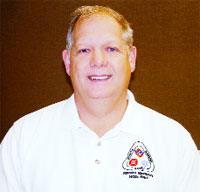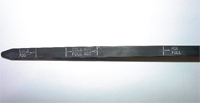
Equipment
Truck Checks: Transmission tips for fire apparatus
The majority of transmissions used in the fire service are automatic
and the Allison automatic has been the transmission of choice for many
years. This transmission is reliable, easy to operate and is very
adaptable to the needs of the fire service. It has some maintenance
concerns that are different from a standard gear transmission. We will
concentrate on maintenance problems of the older mechanical
transmissions and look at the newer electronic transmissions in a
future issue.
March 19, 2008
By Don Henry
 The majority of transmissions used in the fire service are automatic and the Allison automatic has been the transmission of choice for many years. This transmission is reliable, easy to operate and is very adaptable to the needs of the fire service. It has some maintenance concerns that are different from a standard gear transmission. We will concentrate on maintenance problems of the older mechanical transmissions and look at the newer electronic transmissions in a future issue.
The majority of transmissions used in the fire service are automatic and the Allison automatic has been the transmission of choice for many years. This transmission is reliable, easy to operate and is very adaptable to the needs of the fire service. It has some maintenance concerns that are different from a standard gear transmission. We will concentrate on maintenance problems of the older mechanical transmissions and look at the newer electronic transmissions in a future issue.
We often ask new firefighters to inspect the truck; part of this daily or weekly routine would include a check of the transmission oil level. Unfortunately, we do not always tell firefighters what to look for, how to check the oil or under what conditions.
Your department may ask that the transmission oil be checked when the engine oil is checked. The engine oil is almost always checked when the engine is not running but the transmission is checked with the engine running. So, why would a department want the transmission oil checked when the engine is stopped? The simple answer is to make sure that you should even start the engine. Let me explain; when the engine has not been running for a while, the transmission oil level will be very high on the transmissions dipstick – you are looking not for the correct level at this time but to ensure that the oil is not burned (overheated) or contaminated with coolant. If engine coolant has leaked into the transmission, serious transmission damage can occur if the transmission is put into service. If the transmission oil is a milky white or pink, this is a sign that it has been contaminated; do not drive the apparatus. Any amount of engine glycol will cause serious transmission damage. If this condition is found check the engine for a low-coolant level. Warning: never remove a radiator cap from a hot engine as you can be seriously burned.
If the engine coolant is low you can reasonably suspect the transmission oil cooler. The cooler uses engine coolant to remove heat from the transmission oil. There have been numerous cases of internal leaks with these coolers. If you have been reading Truck Checks then you know how strongly I believe in oil and fluid analysis. Let me say this again: even a very small amount of engine coolant will cause transmission failure.
If the transmission oil has been overheated it will have an offensive, burnt odour and therefore the transmission should not be placed into service. When you have determined that the transmission oil is not defective, then start the engine.
(See photo 1) With the engine running at idle, the oil should be at or near the Cold Full line. Allison considers an oil temperature of below 160 F (71 C) to be cold. The final check must be done with the engine level and idling and the oil near the 160 F (71 C) to 220 F (104 C) temperature range. It may be necessary to drive the apparatus to reach theses temperatures. The oil level should now be between the Hot Add and the Hot Full marks. It takes only a small amount of oil to make a big change on the dipstick; do not overfill. Overfilling of the transmission can cause shifting problems and transmission component damage. Use only a clean funnel to add oil and never use a funnel that has been used for engine antifreeze (glycol). Even a small amount of engine glycol will cause transmission clutch damage. Make sure the dipstick is clean and don’t insert a dirty dipstick back into the transmission.
 |
| PHOTO 1 The transmission oil should be at or near the Cold Full line. PHOTO COURTESY DON HENRY
|
WHICH TRANSMISSION OIL TO USE?
Most departments use a General Motors product called Dexron or TranSynd. The current Dexron is called Dexron III. If your department were to use Dexron you could change transmission oil at or before the 12,000 mile mark (19,300 kilometres) or 500 hours. If your older units were specified for Dexron I or II, don’t worry, the new Dexron III is backward compatible.
You may be wondering if you should use the synthetic oil called TranSynd. The Allison Operators Manual recommends this oil be changed at 50,000 miles (80,400 kilometres) or 2000 hours. These numbers are only possible if you drain all the conventional Dexron out and replace it with the TranSynd. My recommendation is to replace the Dexron oil with TranSynd at the next oil and filter change. Before TranSynd became available, many departments in hilly terrain used oil called C-4. Many high-quality diesel-engine motor oils meet the requirements of a C-4 transmission oil. These oils will resist breakdown at high temperatures. This would allow a department to stock only one oil for both the engine and transmission. Many C-4 oils are good motor oils; not all motors oils are good C-4 oils. Check the label on the oil container.
TRANSMISSION IDENTIFICATION
There are basically three models of the no-electronic transmission that you are most likely to encounter. They are AT, MT or HT transmissions. You will need to know which transmission you have to obtain the correct parts, such as oil filters.
AT 500 SERIES
The AT transmission is used in lightweight units and is common in the ambulance market and in fast-attack units with a gross vehicle weight of 26,000 to 30,000 pounds. These single rear-axle units can be gasoline- or diesel-engine driven. The AT came out only as a four-speed transmission and a retarder was even available on certain models.
MT 600 SERIES
The MT is common in single rear-axle fire apparatus units. It was a very popular transmission and it could be used on gasoline- or diesel-powered unit. This transmission could have four or five forward speeds. Units with four speeds were designated as MT600 with the second number being a four, such as a 640 or 643. The five-speed units used the second digit to indicate their forward speeds such as MT 650 or 653. The five-speed models could be either a close-ratio transmission (CR) or a deep-reduction transmission (DR). This extra speed was obtained by the addition on an extra planetary-gear set installed on the rear of the four-speed transmission. This arrangement, with the correct valve body, could give the transmission a deep-reduction speed used mostly for off-road use or a transmission with a close-ratio pattern. This close ratio was most useful with engines that did not have as wide a torque curve as some gasoline engines. The low gear in the deep-ratio transmission is not meant to be used as a starting gear. Instead, drivers were instructed to stop the truck, place the transmission in this very low gear and proceed. When the need for such a low gear has passed, the driver should come to complete stop, select drive or second gear and then continue automatic up shifts as normal.
Do not shift out of or into these low speeds while moving; this will cause extreme stress on driveline components with this model of transmission. It is easy to tell these transmissions apart (DR from CR). Place the transmission in reverse; if you can go faster in reverse than in the lowest forward gear then you have a DR model. If you can go faster in the lowest forward speeds than in reverse then you have a CR model. A retarder was available on all models of the MT 600. This transmission used an internal transmission oil filter; if requested, an external oil filter could be added.
MT 700 MODEL
The HT 700 model was used in aerials, heavy fire pumpers and most tandem-axle units. These units were very similar in design to the MT 600 series but they were larger, able to withstand more engine input power and had a larger GVW. These units did not use an internal filter; rather they used a small screen inside the oil pan and a large external oil filter. They were available as four- or five-speed models and the option was for a CR or DR model was available. The HT could have a retarder and different power take off (PTO) options were available. These options were most useful when used with aerial fire tucks as you could run hydraulic pumps, foam systems or high-pressure, low-volume water pumps off of this options. When installing these PTOs, use only Allison-approved gaskets; never use the older style gaskets made of cork because these can leak and may require the use of a gasket sealant. The use of these sealants is not recommended. If even a small amount of sealant were to get into the transmission fluid it could cause erratic shifting and valve sticking, with disastrous effects.
IDENTIFY YOUR MODEL
On the left-hand side of the transmission there is an identification plate. This plate is also called the SAM plate, for serial, model and assembly numbers. The plate identifies this model as a MT 643; the assembly number is 6884350; and the serial number is 0101818. There are thousands of different variations of the AT, MT and HT models. The assembly number, together with the use of the parts manual, give you this very important information: the governor number; the torque converter ratio; and the engine RPM that the transmission was made to work with.
I cannot stress enough that you should write down the SAM numbers before the plate falls off as it is almost impossible to do any maintenance, repair or diagnostic work without this information. Store these numbers in a safe place.
We’ll complete our look at transmissions in the May issue of Fire Fighting in Canada.
Don Henry teaches in the Automotive Service Technician and Heavy Equipment Technician programs at Lakeland College in Vermilion, Alta., where he has been a faculty member for more than 17 years. He has co-developed and delivers Canada’s only post-secondary level fire-apparatus maintenance program and has completed a textbook on fire apparatus.
Print this page